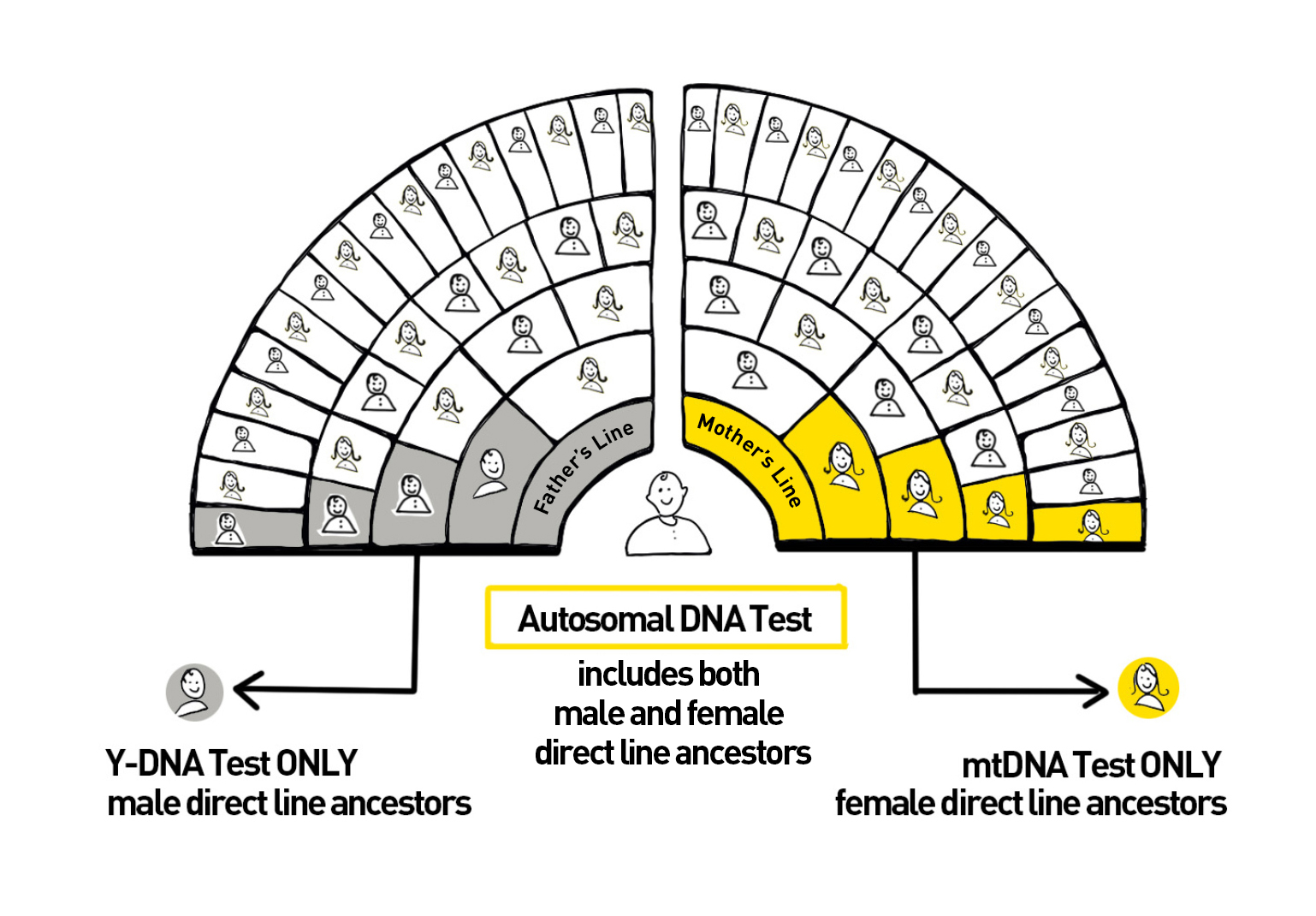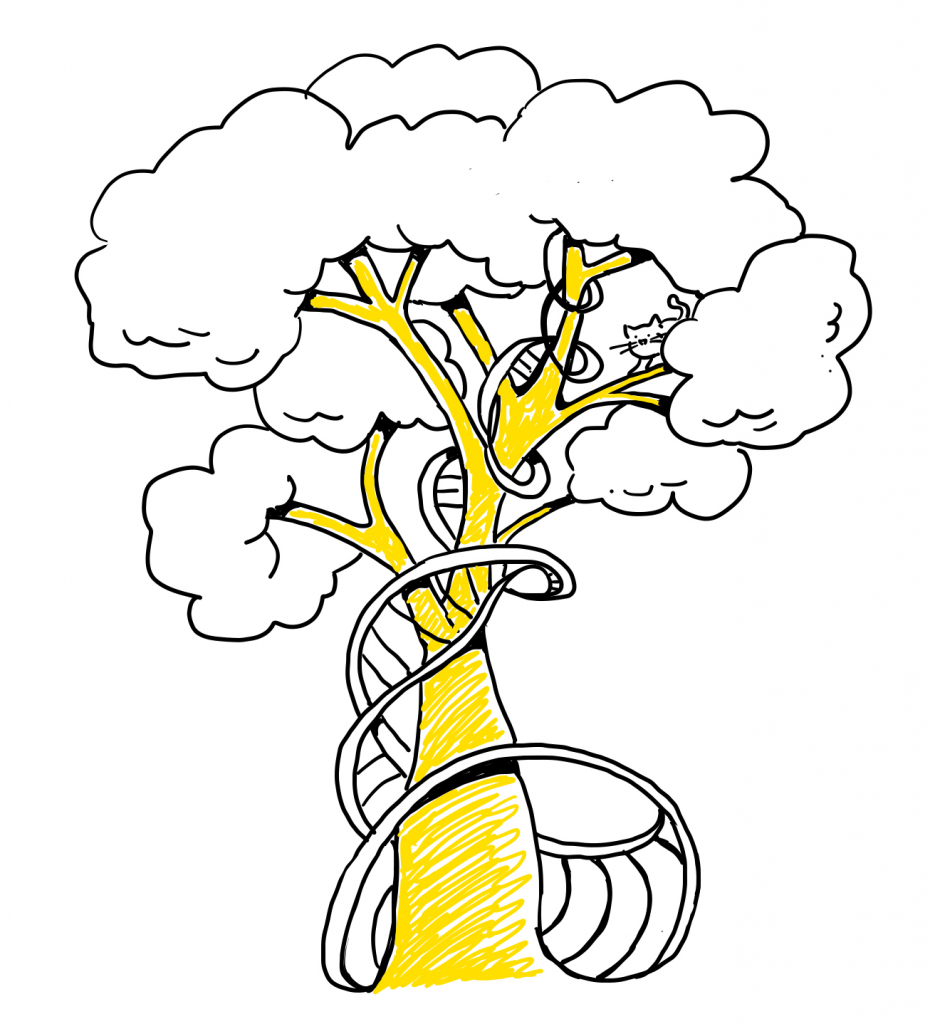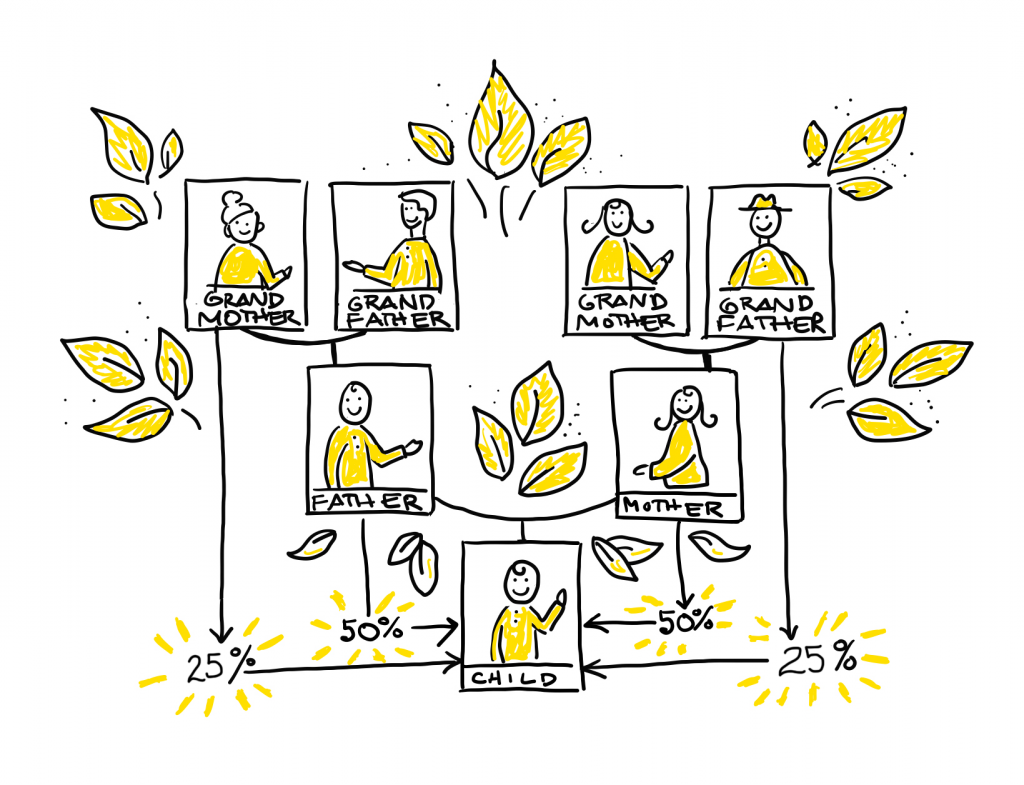An Everyday DNA blog article
Written by: Sarah Sharman, PhD, Science writer
Illustrated by: Cathleen Shaw
Although the latter half of my educational journey was spent studying the biological sciences, I took numerous history courses as an undergraduate. I spent hours lost in the pages of history books or poring over old documents, always eager to learn more, piece together the past, and uncover the stories and events that shaped our world. It’s fascinating to see how people lived, what they believed, and how they interacted with one another in different times and places.
As I transitioned into the sciences, I became captivated by the idea that our DNA contains a record of our ancestors’ lives and that we can use this information to build family trees and uncover new insights into our family history. The field of genetic genealogy combines genetics with historical records to provide a more comprehensive understanding of our ancestry, allowing us to trace our roots back even further and uncover new connections to our past. Let’s learn more about genetic genealogy and how it is being applied today to piece together and understand familial relationships.
What is genetic genealogy?
Humans typically have two copies of 22 chromosomes (the autosomes) plus two sex chromosomes, XX or XY, for a total of 46 chromosomes. We inherit one set of 22 autosomes plus an X chromosome from our mother (maternal chromosomes) and the other 22 autosomes plus a second X chromosome or a Y chromosome from our father (paternal chromosomes). Our parents got half of their DNA from their mother and half from their father. And, at each generation, and for each autosome, we can pass on either the maternal or paternal copy to our children. Closer relatives share larger amounts of DNA because there have been fewer opportunities for chromosomes to get “lost” during reproduction. For example, children have exactly one maternal and one paternal copy of each autosome, meaning they share exactly 50 percent of their DNA with their parents. Grandchildren will share exactly 50 percent of their DNA with their parents but about 25 percent of their DNA with their grandparents. Great-grandparents and great-grandchildren share about 12.5 percent of DNA. Genetic genealogists start constructing a family tree using predicted familial relationships built by shared DNA information, confirm them, and add more branches to the family tree using good old-fashioned historical sleuthing.
The field of genetic genealogy is relatively young but experiencing rapid growth alongside advances in genetic technologies. The first use of DNA analysis for genealogical purposes traces back to the early 1990s, when researchers began using mitochondrial DNA (more about this shortly) to investigate human migration patterns. Several direct-to-consumer genetic testing companies launched in the early 2000s, making it possible for people to learn about their genetic ancestry through simple, at-home DNA tests. Over the years, these tests have become increasingly affordable and accessible, leading to a surge in popularity and widespread use.
The 46 chromosomes contain nearly all of the DNA in human cells and reside in a structure called the nucleus. In addition to nuclear DNA, however, a small amount of DNA is found in another cellular structure called mitochondria, which produce energy inside cells. Initially, scientists and geneticists looked at mitochondrial DNA (mtDNA) to explore relationships between individuals. Unlike nuclear DNA inherited from both parents, mtDNA is only passed down from a mother to her children and can therefore be used to establish familial relationships on the maternal side of a family. Researchers and geneticists can compare mtDNA sequences between individuals to determine if they share a common maternal ancestor. Somewhat analogous to mtDNA testing, which only looks at maternal lineage, Y-chromosome DNA testing provides information about only direct paternal ancestry. This genetic testing method analyzes the Y-chromosome, the sex chromosome only present in males.
As the field grew, genetic genealogists developed increasingly sophisticated methods for analyzing DNA data, using it to build family trees and uncover new relationships. Most major direct-to-consumer genetic testing companies examine autosomal DNA to determine familial relationships. Autosomal DNA testing analyzes DNA from both parents and can provide information about a person’s ethnicity, genealogy, and even potential health risks. Unlike Y-chromosome and mtDNA testing, autosomal DNA testing is not limited to tracing direct maternal or paternal ancestry.

The most common method to analyze autosomal DNA is a DNA array which looks at hundreds of thousands of positions, or markers, across the 22 autosomes. Autosomal DNA testing specifically looks at variations called single nucleotide polymorphisms (SNPs), which are found at the specific locations analyzed by the array. By analyzing the SNPs in an individual’s DNA, scientists can compare them to those in another person’s DNA to determine the degree of relatedness between them. The more SNPs they share in common, the more closely related they are.
Genetic markers alone usually cannot definitively establish familial relationships. Instead, they provide statistical evidence of the likelihood of a relationship. This is because genetic markers can be shared by individuals not biologically related due to chance or population history. However, when combined with other genealogical records and information, genetic markers can be a powerful tool for building family trees and exploring one’s ancestry. By comparing genetic markers, genetic genealogists can uncover new connections and relationships that were unknown and help individuals better understand their family history.
Applications: Family trees
 Genetic genealogy is most commonly used by individuals interested in learning more about their family history and ancestry. By using DNA analysis and genealogical research methods, individuals can build out their family tree, fill in missing branches, and connect with long-lost relatives. Genetic genealogy has become increasingly popular in recent years owing to the increased availability of DNA testing, and it has provided many people with new insights into their families.
Genetic genealogy is most commonly used by individuals interested in learning more about their family history and ancestry. By using DNA analysis and genealogical research methods, individuals can build out their family tree, fill in missing branches, and connect with long-lost relatives. Genetic genealogy has become increasingly popular in recent years owing to the increased availability of DNA testing, and it has provided many people with new insights into their families.
Let’s say I am interested in tracing my ancestry and connecting with relatives I have never met. First, I will take a DNA test with a commercial genetic testing company to receive a list of genetic matches with other individuals in the company’s database. By reviewing the list of genetic matches, I will see DNA matches predicted to be my genetic relatives. Using these potential relatives and my existing known family, I can start building my family tree. This might involve using traditional genealogical records, such as census data, birth and death certificates, and marriage records, combined with genetic data. By examining these records and analyzing my DNA matches, I can start to piece together my family tree and establish connections between relatives.
The more you explore your family history, the more new branches of your family tree you may discover that you weren’t aware of before. You might also identify genetic relatives who you can reach out to and connect with, leading to new family relationships and a deeper understanding of your ancestry. Genetic testing can be a powerful tool for constructing family trees and uncovering new connections between relatives. By combining genetic data with traditional genealogical records, you can build a more comprehensive picture of your family history and gain new insights into your ancestry.
To learn more about the application of genetic genealogy to construct family trees, listen to this Tiny Expeditions podcast episode, “The story of humanity written in your DNA.”
Applications: forensic genetic genealogy
Genetic genealogy has revolutionized the field of law enforcement, providing investigators with a powerful tool to identify suspects in crimes and solve cold cases involving unidentified remains. To identify potential suspects in a crime, forensics experts analyze DNA evidence recovered from a crime scene and then compare it to publicly available genetic data from databases like GEDmatch. By identifying genetic matches between the crime scene DNA and individuals in the database, investigators can construct a family tree and narrow their search for the suspect.
The key to success with genetic genealogy is finding a close enough match in the database to provide a starting point for the investigation. This typically requires a genetic match with a second or third cousin or a more distant relative. Once a potential relative has been identified, investigators will build out the family tree, looking for common ancestors and potential suspects who match the age, location, and other characteristics of the crime.
 Of course, this approach is not foolproof, and there are concerns about privacy and the potential for misidentifications. Critics worry that the technique could be used to implicate innocent individuals or that law enforcement agencies may abuse their access to genetic data. To address these concerns, some states have passed laws regulating the use of genetic genealogy in criminal investigations. Stay tuned for Season 4, Episode 2 of Tiny Expeditions to learn more about the ethical concerns surrounding the use of genetic genealogy in criminal justice.
Of course, this approach is not foolproof, and there are concerns about privacy and the potential for misidentifications. Critics worry that the technique could be used to implicate innocent individuals or that law enforcement agencies may abuse their access to genetic data. To address these concerns, some states have passed laws regulating the use of genetic genealogy in criminal investigations. Stay tuned for Season 4, Episode 2 of Tiny Expeditions to learn more about the ethical concerns surrounding the use of genetic genealogy in criminal justice.
Despite these concerns, genetic genealogy has already been used to solve a number of high-profile cases, including the Golden State Killer case, which involved a series of rapes and murders committed in California in the 1970s and 1980s. In this case, investigators used genetic genealogy to identify a distant relative of the suspect, ultimately leading to the arrest and conviction of Joseph James DeAngelo. This case, along with others, has demonstrated the potential of genetic genealogy to help solve cold cases and bring justice to victims and their families.
Identifying unidentified remains is another critical application of genetic genealogy in law enforcement. This technique involves using DNA analysis to determine the identity of human remains that have been discovered but have not yet been identified. This is often a challenging task, particularly in cases where the remains are very old or have been badly damaged. Genetic genealogy has been used successfully in several cases to identify unidentified remains. The process typically starts with extracting DNA from the remains and comparing it to publicly available genetic data from online databases like GEDmatch or Family Tree DNA. In some cases, this can lead to a genetic match with a known family member, which can then be used to identify the remains. In other cases, the DNA evidence may not lead to an immediate identification, but it can help narrow the search by providing information about the person’s ancestry, ethnicity, and potential geographic origins.
One notable case where genetic genealogy was used to identify unidentified remains is the case of the “Boy in the Box,” a child whose remains were discovered in a box in Philadelphia in 1957. Despite publicity at the time of the discovery and off-and-on throughout the years, his identity remained a mystery. But in 2022, thanks to a breakthrough facilitated by genetic genealogy, the Philadelphia Police Department announced that detectives had determined the boy’s identity as 4-year-old Joseph Augustus Zarelli.
Genetic genealogy proves to be a powerful tool in identifying unidentified remains. By analyzing DNA samples and tracing familial relationships, investigators can provide closure to families and friends of the deceased and bring perpetrators of violent crimes to justice.
To learn more about the use of genetic genealogy in forensics, listen to the Tiny Expeditions podcast episode “The science of crime: forensics and DNA technology.”



